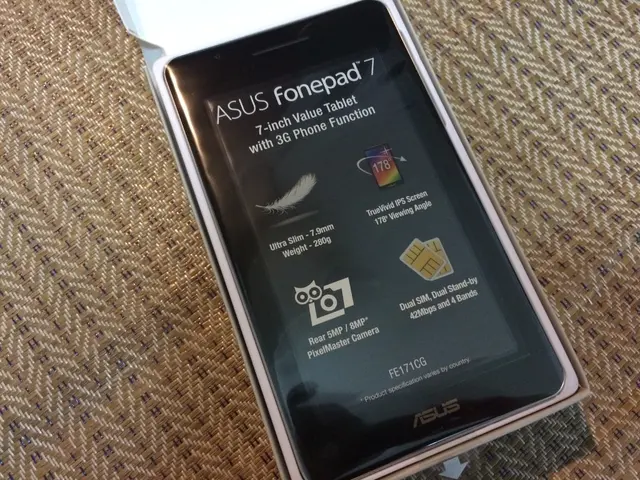Garmin Emergency SOS Functionality: Cost Details and User Guide
The Wilderness Call: What Happens When You Press the SOS Button on Your Garmin inReach?
Exploring the untouched beauty of nature can be an exhilarating experience, but it also carries risks. In such situations, the Garmin inReach SOS feature can prove invaluable, providing a lifeline when you find yourself in trouble. Join us as we delve into the ins and outs of this feature, drawing from real-life rescues, extensive interviews with search and rescue experts, and my personal experience assisting fellow hikers.
In this guide, we'll:
- Clarify when it's appropriate to hit SOS (and when it's not)
- Break down the sequence of events after you trigger the SOS function
- Identify who responds to your call for help
- Discuss the potential costs of a rescue (or how you might avoid them)
To Press SOS or Not to Press SOS?
Countless search and rescue professionals have shared a piece of advice: when you're faced with uncertainty, hit the SOS button. Holding off can exacerbate the situation and make the rescue more challenging. However, if you're merely tired, out of shape, or unwilling to end the hike on your own, don't hit the SOS button. Should you be in genuine distress—lost, injured, or overwhelmed—it's better to seek help promptly.
While you probably won't face punishment for using the SOS function if your request for help is legitimate, you could face financial responsibility or citations for negligence in some areas if you're clearly unprepared or disregarding posted rules. The standard is typically: are reasonable precautions being taken?
This guideline is flexible, taking your experience level into account.
"I'd rather go on a thousand wild goose chases than do a single body recovery." - Search and Rescue Expert
One of the significant advantages of owning a Garmin inReach is that it's a dual communication device. You're not blindly sending out an SOS and hoping for the best. You can explain your situation, answer questions, and obtain advice from the Garmin Response team.
In some cases, they may opt not to dispatch a rescue. Instead, they may advise you to stay put, monitor your condition, or help you devise the safest way out on your own. It's not just about being rescued; it's about receiving the right kind of help at the right time. With this flexibility, you don't have to wait for the crisis to unfold before reaching out. If you're unsure, start the conversation. The earlier you connect, the more options you have.
Here are some scenarios where it usually makes sense to hit the SOS button:
- Medical issues such as pain, lacerations, concussions, or heat or cold problems
- Being lost, running out of water, and having no means to stay overnight
- Being cut off by wildfires, flooding, or rockfall
- Worsening conditions, where you don't believe you can safely self-evacuate
- Motor vehicle breakdowns or accidents
In contrast, here are situations where you likely shouldn't:
- Being tired but knowing your whereabouts and the ability to hike out
- Soreness or blisters but being mobile
- Missing a meetup time but remaining safe and self-sufficient
- Desiring to avoid an uncomfortable overnight situation but having the appropriate gear for it
A secondary advantage of a dual communication device is that if you find yourself in a situation where the SOS button is inappropriate, you can still let a loved one know the situation.
Tip: If you encounter someone else in distress, you can use your inReach to activate the SOS on their behalf. Simply ensure that your message makes it clear that you're not the one requiring help. The Garmin Response team will still coordinate the rescue, directing responders to the injured or lost person. Nearly half of all inReach SOS events involve someone other than the device owner activating the function, often out of good faith and within their abilities. In most places, Good Samaritan laws protect you from liability. Don't let fears of legal repercussions discourage you from assisting someone in genuine need.
The Domino Effect of Triggering SOS
When you trigger an SOS on your Garmin inReach, the following events typically transpire:
- Your SOS is sent to Garmin Response, a 24/7 emergency response center
- They utilize your exact GPS coordinates to calculate your location, which is crucial for a favorable outcome
- During the first 10 minutes, your inReach shares your coordinates every minute
- A dispatcher sends a message to your device, inquiring about the nature of the emergency
- They immediately contact local emergency responders with your location, user details, and any available emergency contact information
- Garmin may also call your phone (listed in your profile) to gather additional details
- Your emergency contacts are also reached out to for information such as your itinerary, party size, medical conditions, vehicle description, and more
- Any messages you send during the SOS are relayed directly to the responding agency
- The SAR team may directly communicate with you through your inReach
- After 10 minutes, the device conserves battery by sending location updates every 10 minutes
- Garmin continues to provide updates to your device and emergency contacts until the rescue is confirmed or the SOS is cancelled
Cancelling the SOS causes Garmin Response to lose the ability to message or track your device. Your device will not reappear on MapShare until the SOS is cleared and the incident is closed.
Note: Ensure that your satellite subscription is active before embarking on your journey. You cannot activate the subscription from the device once you're off the grid.
SOS or 911: Which One to Choose?
If you have cell service or if your phone reads "Emergency Calls Only," dialing 911 may lead to faster assistance than utilizing your inReach. Modern technology enables your smartphone to automatically share your GPS location and medical information with 911. Additionally, you'll have the advantage of being able to speak directly to the operator, often quicker than typing messages over satellite.
However, coverage and dispatcher experience may vary depending on your location. Your call might not reach the closest 911 center, and the one that answers may not be familiar with outdoor rescues. Every search and rescue expert I spoke with recommended contacting 911 first, as this seems to be the best option if you have a cellular connection.
Post-SOS: What to Do Next
Upon triggering SOS, your role changes from the initiator of the rescue to the person being rescued. Here's what you should do:
- Remain in Place: Rescuers are en route to your GPS location. If you move, they may miss you. If you must move due to immediate danger, such as a flash flood, get to safety and then inform the Garmin Response team. You may also be instructed by rescuers to move position.
- Conserve Battery: Put your phone in low-power mode and limit unnecessary usage. Reserve battery life for communication via your inReach.
- Keep Garmin Informed: If your condition changes, send a quick message with the update.
- Stay Visible: Flash a headlamp, blow a whistle, or wave bright gear if a helicopter or team is near.
Note: A helicopter may not always be dispatched. Many rescues involve ground teams, and there may be instances where you are asked to self-evacuate or move to a location more accessible to responders or vehicles. The average response time is at least several hours. Depending on factors like weather and resource availability, it could take days for a rescue to occur.
The Financial Implications of a Rescue
The often-anticipated cost of an inReach rescue is a frequent concern and is often what prevents people from pressing the SOS button. Every search and rescue expert I spoke with had the same message: cost should not deter you from seeking help in an emergency.
- Most backcountry rescues are free. Search and rescue is typically handled by public agencies, but the specific response may vary depending on where you are. For instance, in remote national parks like Big Bend, rescues may be carried out by U.S. Customs and Border Protection helicopters or other federal agencies with resources in the area. Regardless of which agency responds, if you're in genuine need of help, the rescue itself is usually free.
- Medical transport costs may still apply. Even in areas where the rescue itself is normally free, you could be charged if a private provider is used. For example, if you have a serious medical emergency and require air transportation directly to the hospital, you might need to utilize a private air ambulance instead of a park helicopter to a visitor center. These flights can cost anywhere from $5,000 to $60,000 or more, depending on the location and provider.
- Just a ground ambulance from the trailhead to the emergency room can run hundreds to thousands of dollars, with coverage varying on your health insurance.
- Walking out is free. If rescuers help you back to the trailhead, and you're able to get yourself to medical care, there's no charge.
- Negligence can affect the equation. In some states, if you act recklessly, such as hiking closed trails, ignoring weather warnings, or being completely unprepared, you may be charged for the rescue. This is rare but does occur.
- Some states offer protection by registering. In states like New Hampshire, purchasing a Hike Safe Card helps fund SAR and can protect you from being billed unless your actions were knowingly irresponsible. It costs just a few dollars and supports the teams that may one day save your life.
Search & Rescue Insurance
If you're worried about costs, consider obtaining search and rescue insurance. Investing a small amount of money upfront can protect you from massive bills down the line. Here are a few reputable options:
- Garmin SAR Insurance (SAR 100): An optional add-on through your Garmin account that reimburses up to $100,000 in rescue costs. You'll file a claim afterward like regular insurance and may need to proceed through your primary health insurance first. Premiums might be significantly higher in high-altitude locations or for "high-risk" activities.
- Overwatch & Rescue: Operates more like AAA for emergencies. No deductible, no insurance coordination, and no paperwork during the incident. They cover costs directly, including international evacuations for natural disasters or political unrest. The inReach's SOS is routed to Overwatch's team staffed by former EMTs, medics, and other emergency professionals. More info on all the benefits can be found in this video (the source of this information).
Before traveling internationally, research local laws regarding satellite communicators such as the Garmin inReach. Some countries restrict or even ban their use. Examples include China, India, and Russia.
- In the untouched beauty of nature, the Garmin inReach SOS feature can provide a lifeline when faced with genuine distress, such as medical issues, being lost, cut off by wildfires, or worsening conditions.
- Along with the SOS feature, the Garmin inReach serves as a dual communication device, allowing you to explain your situation, answer questions, and obtain advice from the Garmin Response team.
- While in national parks, hiking trails, or other outdoor areas, having appropriate gear like maps, trailheads, and even gadgets like gadgets and technology could be crucial for a safe and successful hiking experience.
- In order to avoid financial responsibility or citations for negligence in some areas, it's essential to take reasonable precautions such as adequate preparation, following posted rules, and knowing when to hit the SOS button.
- When you encounter someone else in distress, you can use your Garmin inReach to activate the SOS on their behalf, potentially saving their life without putting yourself at legal risk due to Good Samaritan laws.






